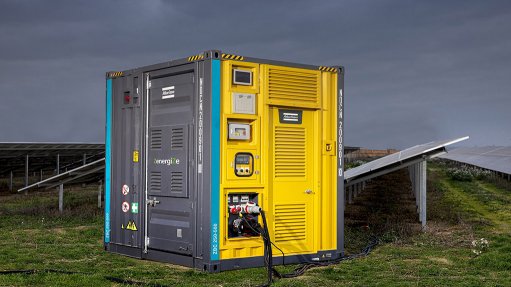
Atlas Copco’s ZenergiZe ZBC solar application
A range of battery energy storage systems promises zero fuel consumption, zero carbon dioxide (CO2) emissions and zero noise.
Such systems present a simpler way to capture and store renewable energy for immediate or later use, ready for delivery at any given time, serving as ideal short-term solutions in applications where there is no access to grid power or where there are low-load issues.
When powered or charged by renewable sources, the ZenergiZe range of battery energy storage systems from Atlas Copco is said to consume zero fuel operating in island mode, produce zero CO2 emissions when used as a standalone power source and the high-density lithium-ion batteries operate silently ensuring zero noise levels.
The units are capable of a 40 000-hour lifespan which translates to more than 5 000 cycles, or more than 1 600 days of continuous operation. The battery energy storage systems are particularly suitable for noise-sensitive environments such as events, metropolitan construction sites, or telecoms. In addition to rental applications, the units are also ideal for small businesses requiring smart power management as well as for large applications with multiple units.
“Our medium 10 kVA to 90 kVA and large 100 kVA to 1 000 kVA ZenergiZe ranges are defined by optimum performance, sustainability and flexibility, taking battery energy storage systems to a whole new level,” notes Atlas Copco Power Technique business line manager portable products David Stanford. “The units can serve as either the primary or standalone power source, replacing a generator in noise-sensitive areas or where fuel fumes or pollutants are not permitted. If the application dictates, they can be combined with a generator to make a hybrid solution and enable smart load management. Furthermore, by combining the units with renewable energy sources such as solar panels, 100% sustainability can be achieved with these systems.”
Owing to significantly reduced fuel consumption and CO2 emissions, the compact energy source is said to offer a profitable and green solution to operators, reducing operating expenses and delivering a low total cost of ownership.
The company explains that the units can work in parallel with other energy storage systems and act as the ‘brain' of a microgrid, storing and managing the power coming from the different sources and regulating the load for each of the applications associated with the microgrid. “The fact that ZenergiZe energy storage systems have two operating modes (island and hybrid mode) allows the end-user to address any peaks in demands,” adds Stanford.
The two models in the medium 10 kVA to 90 kVa range, the ZBP and ZBE, offer rated power of 15 kVA and 45 kVA and energy storage capacity of 45 kWh. A range of socket options are available, aimed at ensuring hassle-free connection to a generator. With a small 1.5 m2 footprint, the medium range units are suited to telecom installations in remote locations and can be used to balance out the peaks in demand and low loads on metropolitan construction sites.
There are four models in the large ZBC 100 kVA to 1 000 kVA energy storage system range, mainly used for demanding applications that require a constant and significant flow of electrical energy. With rated power of 100 kVA and 500 kVA (depending on the model), the parallel capability of this range enables operators to scale with up to 30 ZBCs working in parallel in any power node. The ZBC can store energy from different sources and manage the power supply of small residential areas.